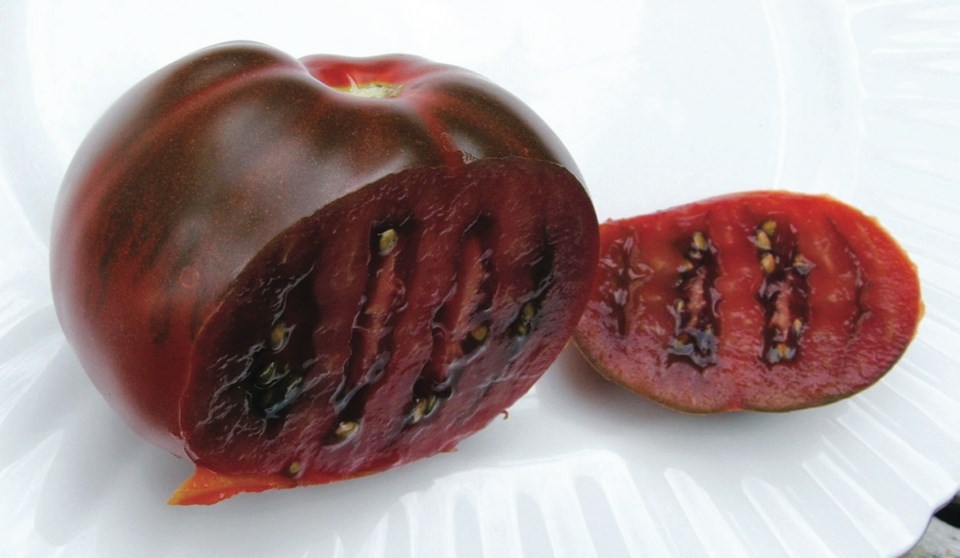One of the experimental changes I made in the garden this year was to diversify the sites for planting tomatoes. My habit of many years was to train the plants against a length of tall wire fencing arranged in a broad arc or wide U-shape depending on the size and shape of the chosen plot. The length of the movable support accommodated all the plants, usually around 17 of them, trained to one main stem and secured as needed against the sturdy fencing.
This year, I decided to eschew the labour of erecting and stabilizing the fencing and instead to use available spaces on three other lengths of wire fencing that are permanent fixtures in the food garden.
I found two spaces at the ends of fencing supporting a trained ‘Peaches and Cream’ honeysuckle — a compact vine graced with fragrant blooms from late spring through the summer.
I planted most of the tomatoes against wire fencing at a long side edge of a vegetable plot. The last two plants became part of a small-space experiment involving runner and pole beans, cucumber and tomato vines, grown up a short length of tall wire fencing in the hottest, sunniest part of the food garden, beside a plot housing a fig tree, strawberries, and raspberries.
This hot spot produced the first really large, fully ripe tomato. It was a Japanese Trifele Black, a Russian heirloom tomato with burgundy-red skin and dark, meaty flesh with a rich, sweet, slightly fruity taste. Seeds for this full-flavoured tomato are available fairly widely. Sources close at hand are Full circle Seeds (Sooke) and Salt Spring Seeds. For further sources, visit seeds.ca and consult the Canadian Seed Catalogue.
Transplants of Japanese Trifele Black tomato are sometimes available in the spring where heirloom tomato plants are sold. I’ve seen them at my local Saturday morning farmers’ market.
Ripening at about the same time, in the last week of July, were smaller black-fruited Indigo Apple tomatoes. Not far behind was Big Beef, my always reliable and prolific producer of tasty tomatoes. These plants are situated with most of the tomatoes, against permanent wire fencing at the long edge of a sizeable vegetable plot.
Food wraps. A Mother’s Day gift from my son has come in very handy this summer. It is a package of three different sizes of food wraps made from pieces of cotton fabric treated mainly with beeswax. The wraps are made by EastVan Bees, a company my son knows well as he is based in East Vancouver and works in the food business there.
I’d been looking at similar beeswax-treated cotton food wraps on display in my local kitchen shop, but had not yet purchased a set of three similar to the ones I was given.
On the day I picked the first, extra-large Japanese Trifele Back tomato and incorporated it into a baked open-faced sandwich, I was left with half of the tomato along with a freshly cut half-cucumber from the garden. To keep them for use the next day, I placed them on a plate and carefully laid the medium-sized wrap over the food and moulded the edges securely under the plate rim.
When I unwrapped the plate the next day I was surprised to find the cut edges of the tomato and cucumber as fresh as I’d left them — no layer of slightly withered cut edge to shave away.
The minimal strip of brown paper enclosing my food wraps gives directions for using and cleaning the wraps, which are made with “upcycled or remnant cotton fabrics.” The wraps are “reusable, plastic-free, antibacterial and compostable” and can last for up to a year.
Coincidentally, just a few weeks ago I overheard a conversation at a farmers’ market stall where I buy eggs. The vendor was gathering friends together for a work party to create their own wraps following directions found on the internet. They were collecting pieces of cotton, beeswax and oil for the project. All the information, including videos, appeared when I typed “Directions for making food wraps with cotton and beeswax” into a search engine.
GARDEN EVENT
Comox meeting. The Comox Valley Horticultural Society meets Monday, 7:15 p.m., in the Florence Filberg Centre, 411 Anderton Ave. in Courtenay. Margot Moser will discuss hellebores — their history, species and new introductions, propagation, and cultivation. Dozens of slides will illustrate the diversity of species and hybrids now available. Doors at 6:30. Non-member drop-in fee $5.



